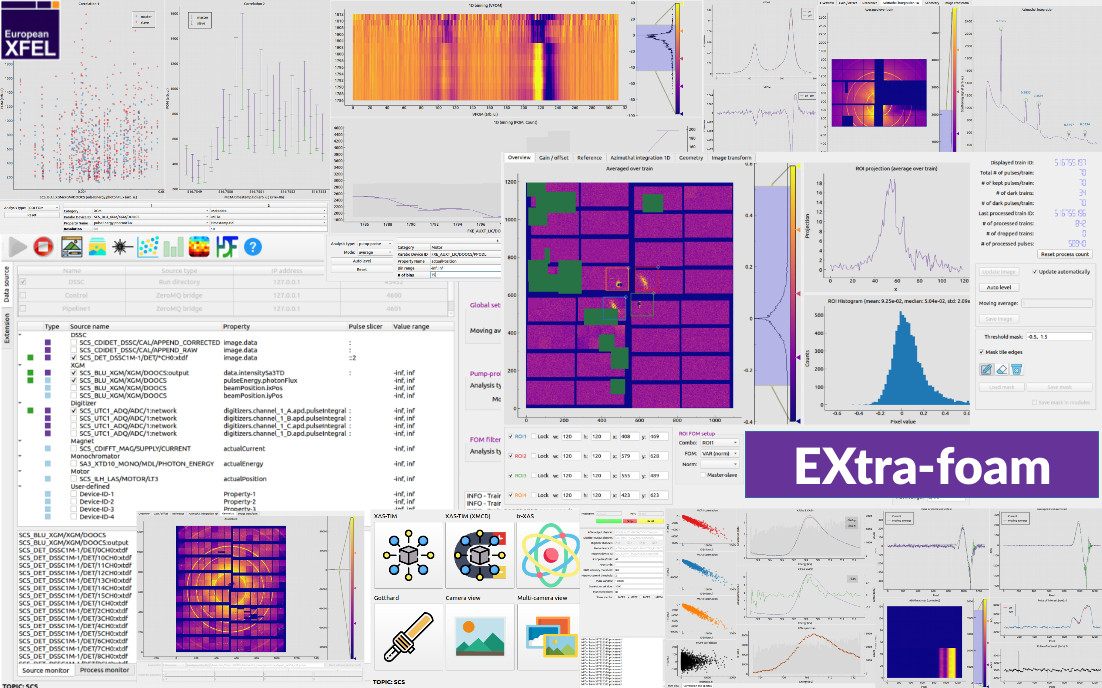Introduction¶

EXtra-foam ( Fast Online Analysis Monitor) is a framework that provides real-time and off-line data analysis (detector geometry, pump-probe, azimuthal integration, ROI, statistics, etc.) and visualization for experiments that use 2D area detectors (AGIPD, LPD, DSSC, FastCCD, JungFrau, ePix100, etc.) and 1D detectors (Gotthard, XGM, digitizer, etc.) at European XFEL.
| online | offline | |||
|---|---|---|---|---|
| raw | calibrated | raw | calibrated | |
| AGIPD | Yes | Yes | Yes | Yes |
| LPD | Yes | Yes | Yes | Yes |
| DSSC | Yes | Yes | Yes | Yes |
| JungFrau | No | Yes | Yes | Yes |
| FastCCD | Yes | Yes | Yes | Yes |
| ePix100 | Yes | Yes | Yes | Yes |
| Basler camera | Yes | Yes | ||
| Gotthard | Yes | Yes | ||
| Digitizer | Yes | Yes | ||
Why use EXtra-foam¶
1. It allows users to perform EDA (exploratory data analysis) in real time by ‘probing’ the data with a combination of different analysis tools, for instance, monitoring individual pulses in a train, checking correlation and trying different normalization methods, etc. This is particularly useful if users are not sure what the data really look like or want to have a sanity check;
2. It provides tailored data analysis configuration and visualization for specific experiments. For example, in pump-probe setup, it allows users to choose how the pump and probe pulses are distributed (e.g. in the same train or different train) by providing several typical “modes”. It also integrates important plots in a single window so that users can gather abundant information in a glance;
3. It allows uses to replay the experiment with files. This is another very useful feature since for both newcomers and veterans. For newcomers, it helps to understand what whey will see during a real experiment by running the ‘replay’ with some sample/real data; for veterans, it helps to optimize the parameters which in turn provides a better real-time monitoring and feedback during experiments. Moreover, When starting a new type of experiment, you may not be able to observe the expected signal during the first run. It could be worthy of double checking the analysis setup by replaying the experiment before searching for other reasons. It is worth noting that the ‘replay’ result could be different from the real-time result if you are using the real-time calibration service from Karabo, since the offline calibration algorithms are more complicated than the real-time ones.
Performance¶
European XFEL can provide X-ray free-electron laser pulse trains (macropulse in accelerator terminology) at a maximum repetition rate of 10 Hz. These pulse trains can be filled with up to 2700 pulses (micropulse in accelerator terminology), corresponding to a maximum intra-train repetition rate of 4.5 MHz. Detectors at European XFEL can be categorized into pulse-resolved and train-resolved ones. Speaking of the performance of real-time analysis, we use the combination of repetition rate (trains/s) and frame rate (pulses/train). For instance, 10 Hz with 64 pulses/train on a DSSC detector means that 640 frames of 1M megapixel images can be preprocessed and analysed per second.
| pulse-resolved/multi-frame detectors | train-resolved/single-frame detectors | |
|---|---|---|
| processing rate | > 10 Hz with 64 pulses/train | > 10 Hz |
Note
Due to the limited performance of PyQt, the visualization rate could be slower than the processing rate if there are too many plots to render, especially for train-resolved detectors.